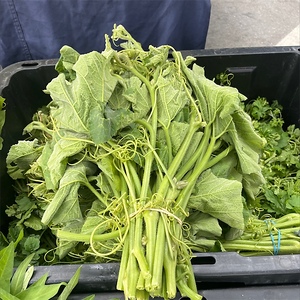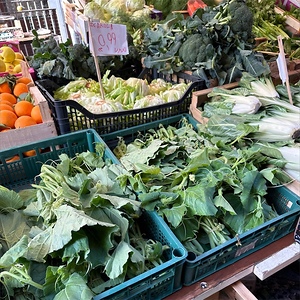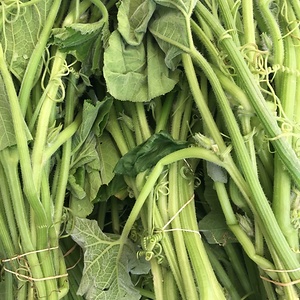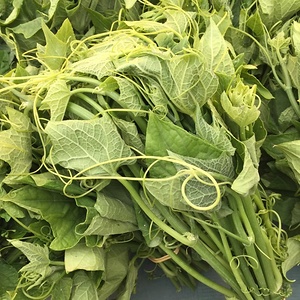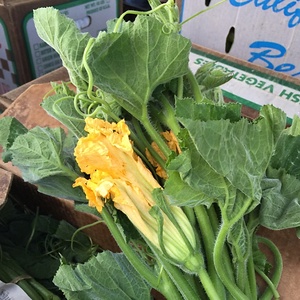

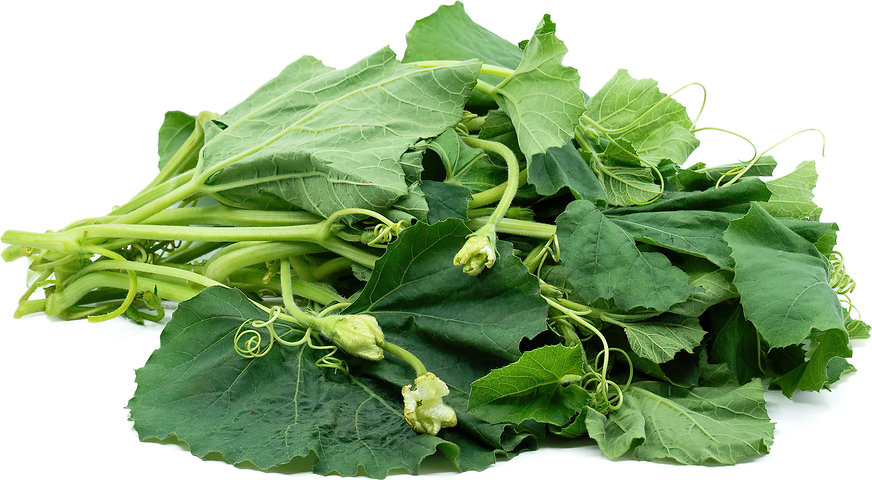
Squash Leaves
Estimated Inventory, bunch : 0
Description/Taste
Squash leaves vary in size and shape, depending on the maturity of the leaves when harvested and the specific variety. The leaves are broad, flat, and pliable, ranging in size from 15 to 25 centimeters in diameter, and have lightly serrated edges. The leaves also appear in shades of green to dark green with light green undersides, and the surface is covered in prominent veining. Squash leaves have a soft, crinkled texture and are sometimes enveloped in prickly hairs, depending on the variety. The leaves are connected to fleshy, snappy, and fibrous pale green stems. In addition to the leaves, small, underdeveloped flowers are sometimes seen growing in between the harvested leaves. Squash leaves, stems, and flowers are edible once cooked and develop a spinach-like texture with a tender, soft, and chewy consistency. Cooked greens release a subtly fresh, green, and grassy aroma and have a vegetal, mild, green, and mineral-forward flavor.
Seasons/Availability
Squash leaves are available year-round.
Current Facts
Squash leaves are a category of edible greens belonging to the Cucurbitaceae family. Several species within the Cucurbitaceae family produce herbaceous, vining plants that trail and climb along trellises, walls, trees, and the ground. These plants thrive in tropical, subtropical, temperate regions and produce edible leaves when young and tender. The term squash leaf is a broad, general descriptor used for edible leaves. Young leaves can be harvested from summer and winter squashes, and leaves from various cultivars labeled as pumpkins, gourds, and zucchini are also sold in markets under the general Squash leaf name. Traditionally, Squash leaves are a secondary ingredient foraged from commercial and home garden plants. Plants are not typically cultivated just for their leaves, but the greens have been valued throughout history for their nutritional properties. They are also often sold as an additional source of income when growers trim the leaves to encourage fruit production during normal cultivation. Squash leaves are utilized in cooked preparations worldwide.
Nutritional Value
Squash leaves are believed to be a source of potassium to balance fluid levels within the body, iron to develop the protein hemoglobin for oxygen transport through the bloodstream, magnesium to control nerve functions, and vitamin C to strengthen the immune system. The greens also provide calcium to build strong bones and teeth, vitamin A to maintain healthy organs, phosphorus to repair tissues, and other nutrients, including copper, zinc, vitamin B, and vitamin K.
Applications
Squash leaves have a mild, green, and vegetal taste suited for cooked preparations. Many Cucurbitaceae species have leaves and stems covered in soft hairs that can be prickly and irritating to the skin. These hairs can be removed by scrubbing the stems or by extended cooking methods. It is important to note that some consumers may wear gloves when handling raw stems and leaves to prevent skin irritation. Squash stems are somewhat fibrous and can be broken in half and stripped of the exterior fibers to create a more tender consistency. Once washed and prepped, Squash leaves and stems can be steamed, stir-fried, blanched and fried, or sauteed in fats as a simple side dish. The greens can also be blanched and cooked into omelets, savory pies, casseroles, soups, stews, and curries. Squash leaves cook down considerably, and large portions can be sourced raw and will be almost cut in half once cooked. In Italy, Squash leaves are cooked and tossed with pasta, minced into meatballs, served with potatoes and tomatoes, or used as a wrap to stuff fillings of cheese, bread, bacon, eggs, and herbs. In Africa, Squash leaves are added to porridges, stews, beans, and various sauces. Squash leaves are used in similar preparations worldwide and are primarily used in savory recipes. In India, Squash leaves are stuffed with fillings, rolled into a pocket and fried, or mixed into curries. In the Philippines, Squash leaves are cooked in coconut milk with shrimp, beans, and squash flowers and served over rice. They are also mixed into noodle dishes throughout Southeast Asia. Squash leaves pair well with meats such as poultry, beef, and pork, seafood including fish, shrimp, and crab, tomatoes, potatoes, aromatics such as garlic, onions, and ginger, and spices including curry powder, turmeric, and cardamom. Whole, unwashed Squash leaves have a short shelf life and wilt easily. They should be immediately used after harvest for the best quality and flavor. The leaves should be placed in a container of water and stored in a plastic bag in the refrigerator to preserve the greens for a few days.
Ethnic/Cultural Info
In Sicily, tenerumi is a traditional term used for harvested greens from the cucuzzi squash. The name tenerumi roughly translates from Sicilian dialects to mean “tender,” and only the young leaves and stems are seasonally picked from the plants for culinary use. Historically, tenerumi was a symbol of peasant cuisine in Sicily, but over time, the rustic dishes incorporating the leaves and stems became treasured recipes of Sicilian families. Tenerumi is famously used in pasta dishes and a refreshing summertime soup. This seasonal soup is made with herbs, tomatoes, pasta, parmesan, and aromatics and is served warm with crusty bread. Tenerumi has remained a seasonal delicacy into the modern day and is considered a light ingredient. In Sicily, when someone refers to eating pasta with tenerumi, they are referring to eating a dish low in calories, alluding to eating almost nothing.
Geography/History
Several species within the Cucurbitaceae genus are native to the Americas and have been growing wild since ancient times. It is important to note that some species within the Cucurbitaceae family are native to other regions, including Asia, but for the purposes of this article referencing species with edible leaves for culinary use, most are descendants of species from the Americas. There are multiple regions within the Americas thought to be centers of origin for various species with edible leaves, and over time, the species were spread throughout the Americas among indigenous populations. Cucurbitaceae species were later carried from the New World sometime in the late 15th and 16th centuries and planted throughout Europe, eventually moving east into Asia. Since its introduction worldwide, these species have been domesticated and selectively bred to produce plants with improved cultivation traits. Fruits are the primary reason for most plant cultivation, but the young, tender leaves are also harvested as a secondary crop for culinary use. Today, Squash leaves are a small-scale ingredient incorporated worldwide into various cooked preparations. Harvested leaves are not commonly found in commercial retailers, but the stems and leaves are bundled and offered through local markets, farmer’s markets, and directly through growers. Squash leaves are also grown and picked from home gardens worldwide. The Squash leaves featured in the photograph above were sourced through Capo de Mercato in Palermo, Sicily.
Recipe Ideas
Recipes that include Squash Leaves. One
| Pranee's Thai Kitchen |
|
Winter Squash Leaves in Salted Coconut Milk |
| Jennifer's Kitchen |
|
Squash Greens |



